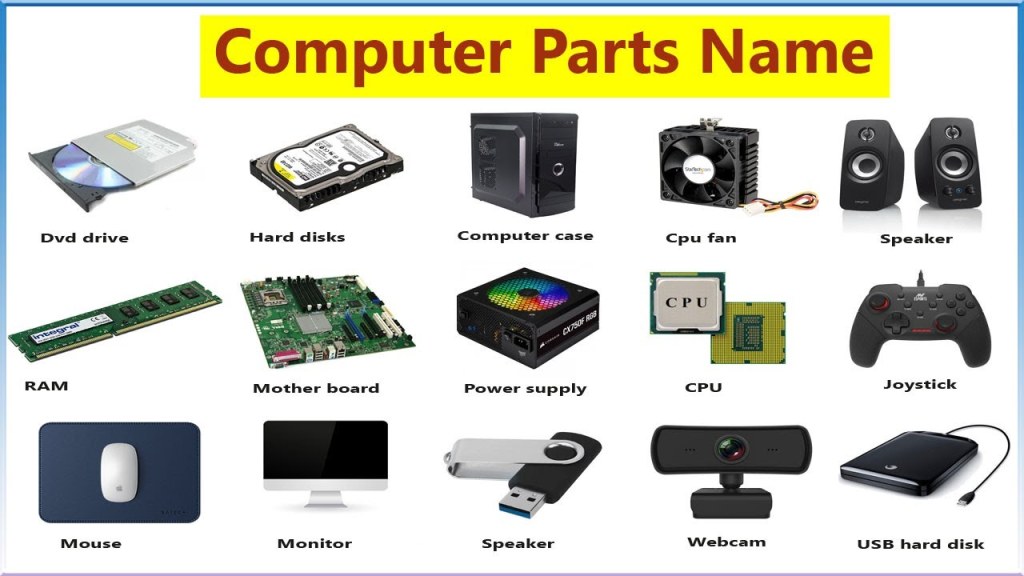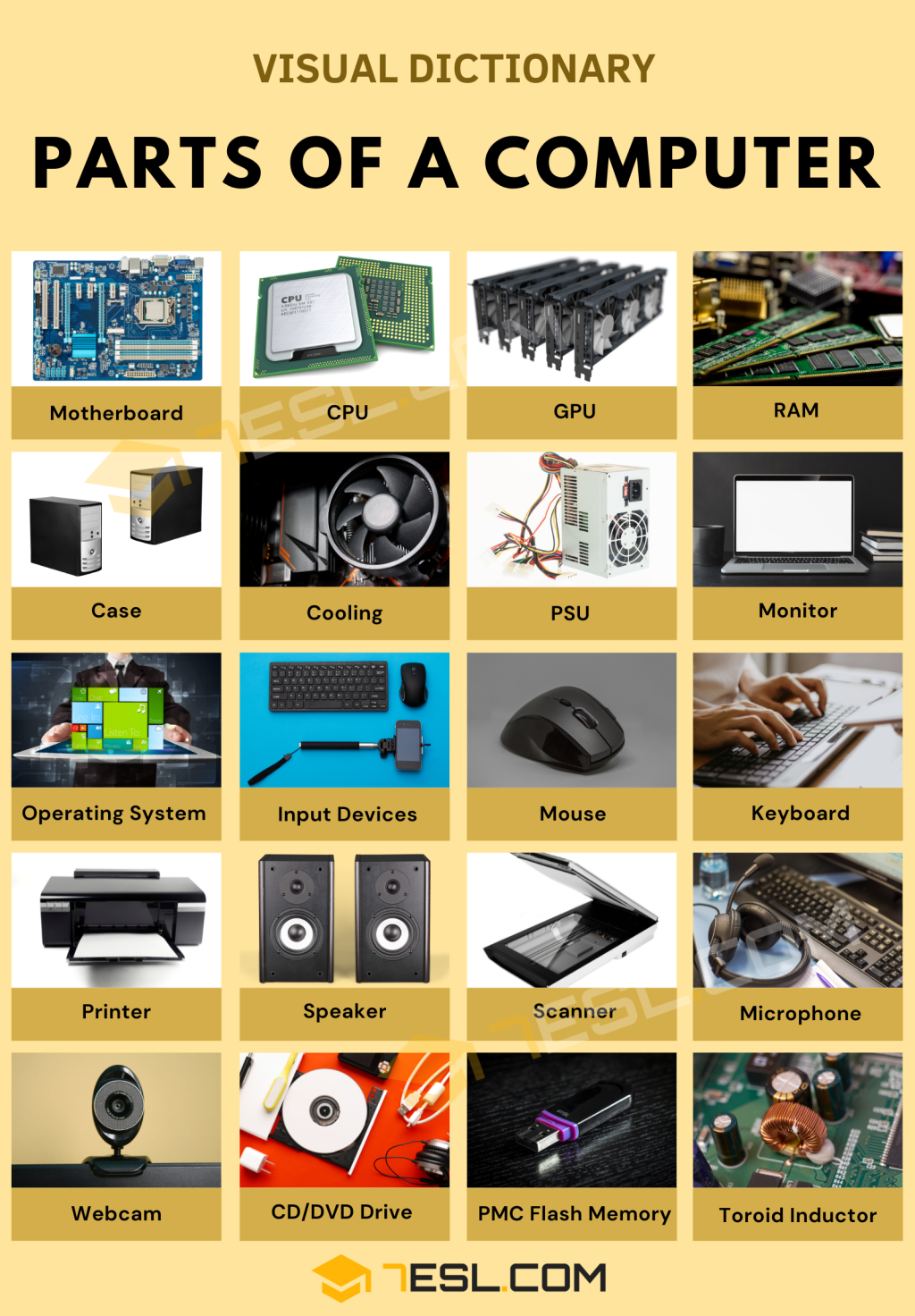Computer Accessories Name List
Introduction
Dear Readers,
Welcome to our comprehensive list of computer accessories! In this article, we will provide you with an extensive collection of computer accessories that are essential for enhancing your computing experience. Whether you are a tech enthusiast, a professional gamer, or simply someone who wants to optimize their productivity, this list will help you find the perfect accessories for your needs.

Image Source: ytimg.com
Without further ado, let’s dive into the world of computer accessories and discover the must-haves for your setup!
Table of Contents
1. Keyboards
2. Mice

Image Source: 7esl.com
3. Monitors
4. Headsets
5. Speakers
6. Printers
7. Webcams
8. External Hard Drives
9. USB Flash Drives
10. Mousepads
11. Laptop Stands
12. Surge Protectors
Keyboards
What: Keyboards are input devices that allow users to enter text, commands, and perform various functions on a computer. They come in different types, such as mechanical, membrane, and ergonomic keyboards.
Who: Keyboards are essential for anyone who uses a computer, whether it’s for work, gaming, or casual browsing.
When: Keyboards have been around since the early days of computers and continue to be a fundamental accessory for modern computing.
Where: Keyboards are used in various settings, including offices, homes, schools, and gaming centers.
Why: Keyboards provide a tactile and efficient way to input data and control a computer. They are essential for typing, gaming, programming, and other tasks.
How: Keyboards connect to computers through wired USB or wireless Bluetooth connections. Some keyboards also offer customizable features and backlighting options.
Mice
What: Mice are pointing devices that enable users to move the cursor on a computer screen and interact with the graphical user interface.
Who: Mice are used by anyone who operates a computer, whether it’s for work, design, gaming, or casual use.
When: Mice have been an integral part of computer accessories since the advent of graphical user interfaces.
Where: Mice are used in various settings, including offices, homes, schools, and gaming centers.
Why: Mice provide precise control and navigation on a computer screen, making them essential for productivity, design work, gaming, and general usage.
How: Mice connect to computers through wired USB or wireless connections. They come in various designs, including optical, laser, and trackball mice.
Monitors
What: Monitors are display devices that present visual information generated by a computer. They come in different sizes, resolutions, and technologies.
Who: Monitors are used by anyone who requires visual output from a computer, including professionals, gamers, and casual users.
When: Monitors have been an integral part of computing since the early days of personal computers.
Where: Monitors are used in various settings, including offices, homes, schools, and entertainment centers.
Why: Monitors provide a visual interface for users to view and interact with the content on their computers. They are crucial for productivity, entertainment, design work, and gaming.
How: Monitors connect to computers through various interfaces, such as HDMI, DisplayPort, or VGA. They utilize different panel technologies, including LCD, LED, and OLED.
Headsets
What: Headsets are audio devices that combine headphones and a microphone, allowing users to listen to audio and communicate with others.
Who: Headsets are used by professionals, gamers, content creators, and anyone who requires audio input and output on their computers.
When: Headsets have become popular with the rise of online communication, gaming, and multimedia content.
Where: Headsets are used in various settings, including offices, homes, gaming centers, and recording studios.
Why: Headsets provide high-quality audio output and enable clear communication, making them essential for gaming, virtual meetings, content creation, and multimedia consumption.
How: Headsets connect to computers through wired USB, 3.5mm audio jacks, or wireless Bluetooth connections. They come in different designs, including over-ear, on-ear, and in-ear headphones.
Speakers
What: Speakers are audio output devices that produce sound from a computer. They come in various sizes, configurations, and power outputs.
Who: Speakers are used by anyone who wants to enhance their audio experience on a computer, whether it’s for entertainment, multimedia consumption, or professional purposes.
When: Speakers have been an essential part of computer accessories since the early days of multimedia content.
Where: Speakers are used in various settings, including offices, homes, entertainment centers, and recording studios.
Why: Speakers provide high-quality audio output, enabling users to enjoy music, movies, games, and other multimedia content with immersive sound.
How: Speakers connect to computers through wired 3.5mm audio jacks, USB, or wireless Bluetooth connections. They can be standalone units or part of a surround sound system.
Printers
What: Printers are output devices that produce physical copies of digital documents, images, or other content stored on a computer.
Who: Printers are used by professionals, students, and anyone who needs to print documents, photos, or other materials.
When: Printers have been an indispensable part of computer accessories since the need for physical copies arose.
Where: Printers are used in various settings, including offices, homes, schools, and businesses.
Why: Printers enable users to generate hard copies of important documents, photos, and other materials for archiving, sharing, or reference purposes.
How: Printers connect to computers through wired USB or wireless connections. They utilize different printing technologies, such as inkjet, laser, or thermal.
Webcams
What: Webcams are video input devices that capture and transmit live images or video recordings to a computer.
Who: Webcams are used by individuals, professionals, and businesses for video conferencing, live streaming, video recording, and online communication.
When: Webcams have gained popularity with the rise of video conferencing, online communication platforms, and content creation.
Where: Webcams are used in various settings, including offices, homes, schools, and streaming studios.
Why: Webcams enable users to have face-to-face interactions, create video content, attend virtual meetings, and engage in live streaming activities.
How: Webcams connect to computers through USB ports and utilize built-in or external microphones for audio input.
External Hard Drives
What: External hard drives are portable storage devices that connect to a computer and provide additional storage capacity for files, documents, and multimedia content.
Who: External hard drives are used by individuals, professionals, and businesses that require extra storage space for backups, file transfers, and data organization.
When: External hard drives became popular as the need for additional storage capacity grew with the increasing amount of digital content.
Where: External hard drives are used in various settings, including offices, homes, schools, and for on-the-go storage.
Why: External hard drives offer a convenient and portable solution for storing and transferring large amounts of data, ensuring data security and backup.
How: External hard drives connect to computers through USB ports and utilize various storage technologies, such as HDD (hard disk drive) or SSD (solid-state drive).
USB Flash Drives
What: USB flash drives, also known as thumb drives or memory sticks, are portable storage devices that connect to a computer’s USB port.
Who: USB flash drives are used by individuals, students, professionals, and anyone who needs to transfer or store small to medium-sized files.
When: USB flash drives gained popularity as a compact and convenient alternative to floppy disks and CDs for file storage and transfer.
Where: USB flash drives are used in various settings, including offices, homes, schools, and for on-the-go storage.
Why: USB flash drives offer a portable and reliable solution for quickly transferring files between computers, sharing data, and creating backups.
How: USB flash drives connect to computers through USB ports and come in various storage capacities, designs, and speeds.
Mousepads
What: Mousepads are accessories used to provide a smooth and even surface for computer mice to glide on.
Who: Mousepads are used by individuals, gamers, and professionals who want to optimize mouse movement and accuracy.
When: Mousepads have been popular since the early days of computer mice, providing a consistent surface for smooth cursor movement.
Where: Mousepads are used in various settings, including offices, homes, gaming centers, and design studios.
Why: Mousepads improve mouse precision, reduce friction, and protect surfaces, allowing for smoother cursor movement and enhanced gaming or work experiences.
How: Mousepads come in various sizes, materials, and designs, ranging from basic cloth mousepads to high-performance gaming mousepads with specialized surfaces.
Laptop Stands
What: Laptop stands are accessories designed to elevate laptops for improved ergonomics, comfort, and cooling.
Who: Laptop stands are used by individuals, professionals, students, and anyone who frequently works on a laptop for extended periods.
When: Laptop stands gained popularity as the use of laptops became more prevalent, requiring better positioning and ventilation.
Where: Laptop stands are used in various settings, including offices, homes, schools, and coffee shops.
Why: Laptop stands promote better posture, reduce strain on the neck and wrists, enhance airflow for cooling, and provide a more comfortable typing experience.
How: Laptop stands come in various designs, including adjustable height and angle options, and can be made of materials such as aluminum, plastic, or wood.
Surge Protectors
What: Surge protectors, also known as power strips, are accessories designed to protect electronic devices from voltage spikes and electrical surges.
Who: Surge protectors are used by individuals, professionals, and anyone who wants to safeguard their valuable electronic equipment.
When: Surge protectors have become essential as the reliance on electronic devices has increased, protecting against power fluctuations and potential damage.
Where: Surge protectors are used in various settings, including offices, homes, schools, and entertainment centers.
Why: Surge protectors prevent damage to electronic devices caused by power surges, ensuring longevity and protecting against data loss.
How: Surge protectors are equipped with multiple outlets and often include features such as surge indicators, USB charging ports, and built-in circuit breakers.
Advantages and Disadvantages of Computer Accessories
Advantages:
Enhanced productivity and efficiency
Improved gaming experience
Increased storage capacity
Better audio and visual output
Convenient file transfer and data backup
Disadvantages:
Cost of acquiring multiple accessories
Potential compatibility issues
Additional space requirements
Increased power consumption
Reliance on external devices
Frequently Asked Questions (FAQ)
1. Can I use a wireless keyboard and mouse